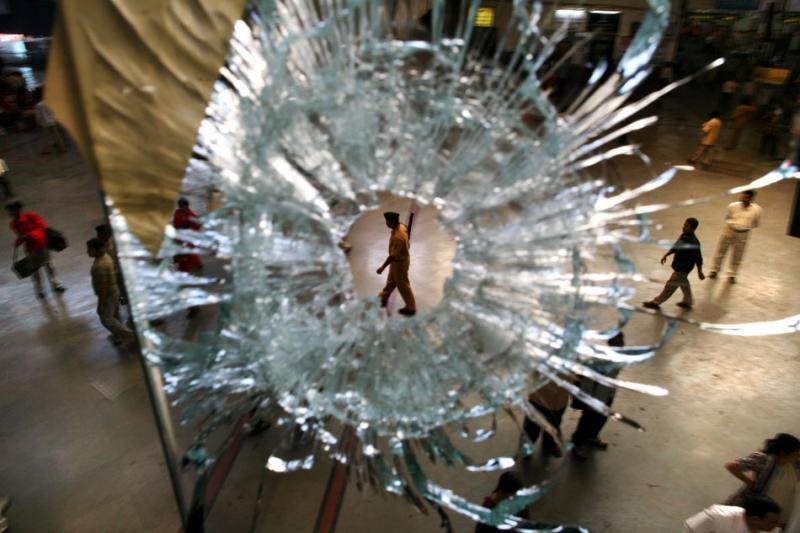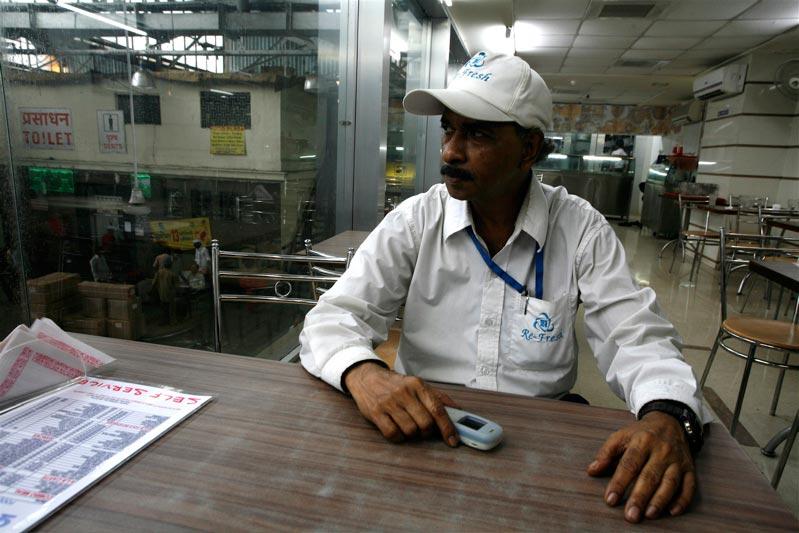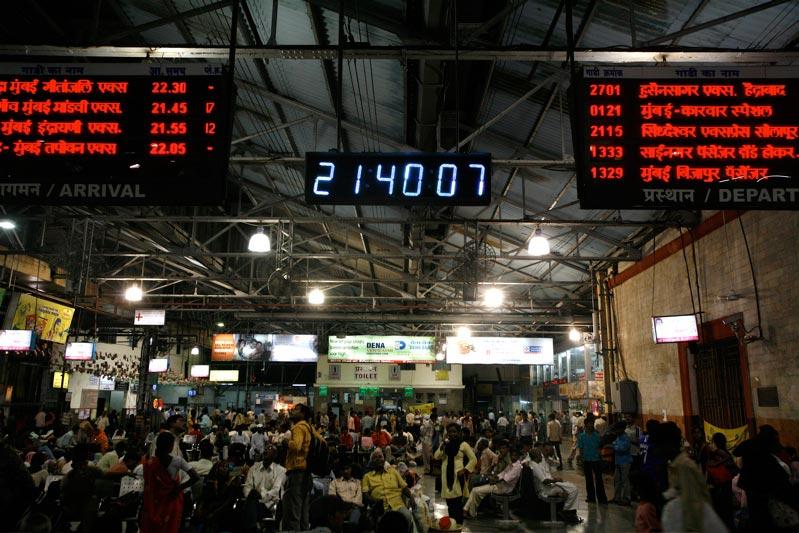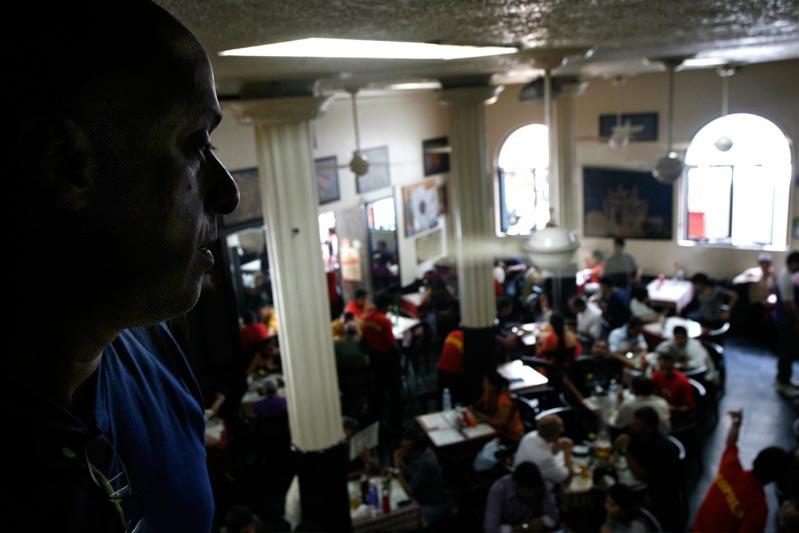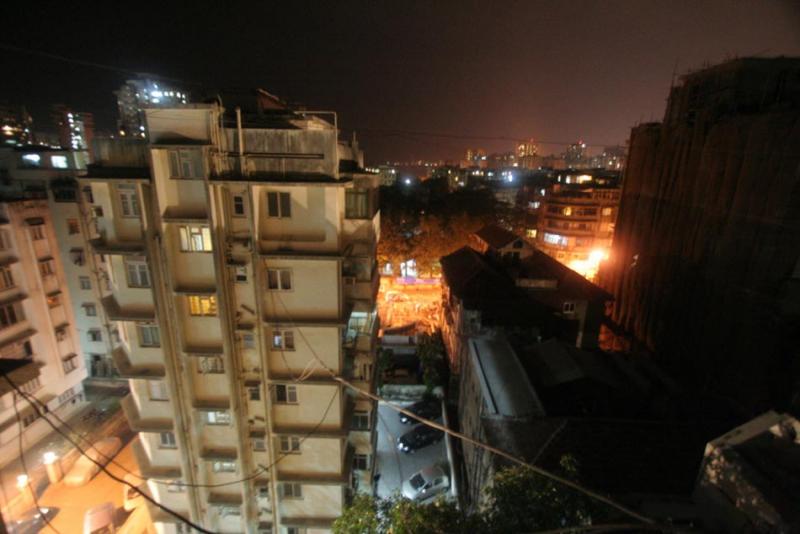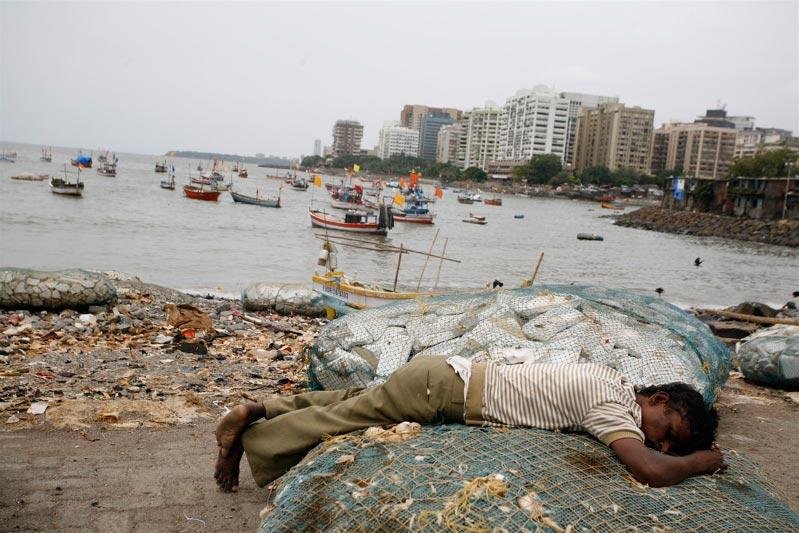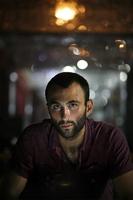
Sixty Hours of Terror

Editor’s Note: This is part one of a four-part series on the November 2008 terror attacks in Mumbai.
I. Ten Gunmen, Ten Minutes
November 26, 2008. 9:40 P.M. Chhatrapati Shivaji Terminus.
Chhatrapati Shivaji Terminus (CST) hummed with the foot traffic of late commuters. Under hulking steel rafters, held over from the British colonial era, the PA announcer issued final calls for departing suburban trains as they lurched away one after the next, packed with passengers. Long-distance travelers, mostly the poor North Indian migrants who flock to the city by the tens of thousands, took up benches and spots on the concrete floor, resting on sheets of newsprint with their piles of luggage.
Fongen Fernandes, the spry fifty-three-year-old manager of the upper level of the Re-Fresh snack bar with its tall glass panels overlooking the platforms, was talking to a graphic designer. Fernandes stood admiring the designer’s digital handiwork on a laptop open at a table in the far corner of the restaurant, when he felt sand-like debris sprinkle the top of his head. “What’s this?” he said to himself. He wiped his smooth pate a couple times and continued talking, unaware that below two young men had emerged from a bathroom abutting Platform 13 and begun spraying the crowd with gunfire, unaware that a high-velocity bullet shot from less than thirty yards away had missed him by inches and lodged in the wall over his shoulder. He bid the designer farewell and was halfway down the stairs when another series of rounds cracked against the wall and showered sparks into the air. A grenade exploded on the platform.
Rattled by the sudden chaos, Fernandes scrambled back upstairs, cut the lights, and ducked behind some advertising placards that were pasted to the base of the snack bar windows. He instructed everyone to slide belly-down and hide behind a bank of metal food warmers. One woman started to scream. He motioned for her to shut up. When she wouldn’t, Fernandes threw his handkerchief to a waiter who held it to her mouth. “Don’t let go of her,” he said.
Fernandes stole a look at the scene below. Bodies lay scattered on the station floor, slicked in blood. The gunmen scanned and swiveled. They shot from the hip, in steady bursts. The shorter, stocky one, Mohammed Ajmal Amir Kasab, wore beige cargo pants and a blue t-shirt with VERSACE printed in white on the chest; the other, Ismail Khan, was slimmer and wore all black. Both carried rucksacks. On any other day, Fernandes would have taken them for college boys on their way home. These were no students, though. The ease with which they wielded their weapons amid the panic betrayed a professional’s mien.
Two more volleys lashed into the snack bar. One hit Mukesh Aggarwal, a co-worker in charge of the ground level, in the stomach. Fernandes, a devout Catholic, started to pray in the dark. “St. Anthony, please deliver us . . .”
9:40 P.M. Leopold Café.
Two young men—one named Abu Shoaib, the other known simply as Nazir—got out of a yellow and black city cab across the street from the Leopold Café. Open since 1871 in the heart of the Colaba district, the multi-level dive was packed with more than a hundred people enjoying western food and cheap pints of Kingfisher beer to the din of rock music that spilled onto the sidewalk, where hawkers plied t-shirts and offered hash to foreign backpackers.
Co-owner Farhang Jehani stepped out to take a phone call. He watched the pair of young men pay the cab fare and wait by the curb, bags slung over their shoulders. Driver Fulchand Bhind was grateful for the extravagant tip the young men had given. Unbeknownst to him, the two men had slipped a bomb, set to go off in one hour, under his seat. As Bhind pulled away, the bomb clicked silently toward detonation. How could he have known? These young men certainly didn’t look like terrorists. Jehani, across the street, assumed they were students waiting for friends. When his call was finished, he went inside and around to the back staircase that leads to the mezzanine-level bar to watch the cricket match. India was playing England, and they were winning. Jehani’s family is part of Mumbai’s long-established Parsi community, émigrés from Iran who practice the Zoroastrian faith, but like any lifelong Indian, he is passionate about cricket.
Outside, Shoaib and Nazir glanced one last time at a watch. It was 9:40 P.M. They hugged and reached into their bags. One tossed a grenade into the restaurant. Then they opened fire together. The shriek of shattering mirrors pierced the room. Some patrons bolted for an exit at the opposite side of the parlor; others tried to hide behind upset tables and chairs. Upstairs Jehani hit the ground. He didn’t think the gunmen would know about the second level but wasn’t sure; a panel of violet stained glass could reflect shadows so he whispered for a bar hand to cut the lights. Maneuvering low to secure the door at the foot of the stairs, he saw that someone had already jammed a table against the handle.
The attack was over in less than two minutes. Shoaib and Nazir fled down an alley toward the Taj Mahal Palace & Tower, a five-star Mumbai landmark with towering red domes and expansive views of the Arabian Sea just two blocks away. At least five people were gunned down in their path, including a waiter who had worked at the café for seventeen years; another seven people, four foreigners and three Indians, lay dead inside. Two empty magazines rested on one of the few tables left standing. Outside, patrons were flagging down cabs to carry the wounded to the hospital.
9:40 P.M. Nariman House.
Nariman House sat on a dark-lit backstreet in a working-class area of Colaba market, a brisk ten-minute walk from Leopold Café. The narrow, pale building was the headquarters of the ultra-Orthodox Chabad Lubavitch movement and a haven for Mumbai’s dwindling Jewish community. Known to the faithful as Chabad House, the center also served as a home away from home to Israeli travelers wishing to celebrate holidays and eat kosher while abroad. Amid the swarm of the city, it was likened by some to a lighthouse.
Its reputation for warm hospitality toward strangers was the product of its caretakers, thirty-year-old Rabbi Gavriel Holtzberg of Brooklyn, New York, and his wife Rivka. Five travelers who had stopped by earlier in the day had stayed on for dinner: David Bialka, a middle-aged Israeli diamond trader and regular guest during business visits; Yocheved Orpaz, a retired Israeli woman, on vacation; Norma Shvarzblat Rabinovich, a Jew from Mexico visiting en route to Israel; and two younger American Jews living in Israel, Rabbi Aryeh Leibish Teitelbaum and Bentzion Chroman, who had come to Chabad to instruct the Holtzberg’s Muslim chef, Qazi Zakir Hussain, in the preparation of kosher food. After saying their evening prayers together, the guests retired to their rooms on the forth and fifth floors for the night. On the second floor Rabbi Holtzberg and his wife were taking stock of food supplies ahead of Shabbat festivities when they heard a series of bangs outside.
Sandra Samuel was in the kitchen, cleaning up after dinner, when she heard the commotion but assumed it was firecrackers. Samuel worked for the Holtzbergs as a nanny to the couple’s two-year-old son Moshe. Their first son Menachem Mendel had died of Tay-Sachs in 2006. Their second, Dov Ber, was hospitalized and deathly ill with the disorder. But Moshe was perfectly healthy. He was the malach of the house, their angel and miracle. After the brief disturbance, Samuel and Hussain, the cook, had just gone back to putting leftovers in the refrigerator when she spotted the darkened figure of an armed man in the hallway. Samuel and Hussain sprinted for the adjacent library and locked the door behind them. Samuel called out for help from the balcony, but she crouched back inside when the firing intensified. A grenade blast shook the first floor. It ripped plaster off the walls and the library door from its hinges.
Upstairs in his spartan fourth floor room, David Bialka’s mind raced. His first thought was to try to descend the staircase, but it was dense with acrid smoke. The only way out was the bathroom window; all the other windows had iron grills. He squeezed himself through and clung fiercely to a drainpipe, sliding down to an air conditioning unit. There he could look down and see the crowd at street level. Several were shouting at him and threw rocks at the floors above. Hesitantly, he moved down to another AC unit and then decided to jump the last two floors to the ground. Angry neighbors initially mistook him for a gunman, yanking at his clothes and landing punches.
Back inside, in the noise and confusion, Rabbi Holtzberg made a last-second phone call to the Israeli Consulate. It was a cool plea for help. “The situation is not good,” he told the officer on duty in Hebrew. The line went dead. Rivka, six months pregnant, tightly clutched Moshe, who would not stop crying as the gunmen, two men named Babar Imran and Nasir, made their way up to their second floor living quarters.
9:40 P.M. Trident-Oberoi Hotel complex.
Dressed in a starched sherwani and a black turban seamed with gold, the Sikh doorman smiled namaste greetings to hotel guests emerging from luxury sedans. The rickety taxi that pulled up to the base of the driveway struck a sharp but familiar contrast. Mumbai is a city of such contradictions, the divide between opulence and privation so commonplace as to go unnoticed. Two young men, Abdul Rehman and Fahadullah, stepped out of the cab, and made their way up the ramp to the dwarfing eighteen-story Trident hotel. They stopped short of the main entrance, dropped their shoulder bags, withdrew assault rifles, and unleashed a salvo of bullets at the façade of a Gucci boutique just opposite. One employee was struck. The Sikh doorman and the rest of the door staff ran for their lives, while one of the gunmen placed a white travel bag containing a ticking bomb on the ground. It was the first of two bombs they would plant around the complex. The gunmen then walked back to the hotel doors and announced their entry with another burst of rounds.
Although the airy open gallery to the left was empty of people, the gunmen fired a few more perfunctory shots to break glass, revving themselves for the kill. Turning to their right, they approached the baggage counter. A bellboy and a service staff member cowering behind it were left sprawled in a pool of blood. The gunmen pressed forward into the main lobby, chasing screams with volleys of bullets. At the elevator bank around the corner from the reception area, a Japanese businessman, Hisashi Tsuda, stepped out into view of the gunmen, who leveled their rifles. Tsuda made an about face but was shot in the back as the doors slammed shut. Together Rehman and Fahadullah stormed into the Opium Den restaurant at the far end of the lobby. One guest who had lingered was struck down by the fusillade. Four more people, three hotel staff and another guest, were found and killed in an equipment room.
The gunmen headed back to the lobby and up a flight of stairs to a shopping concourse that led to the adjoining Oberoi. Still more glass storefronts crumbled under fire. Just to make sure no authorities were in pursuit, they doubled back, and then continued on, killing another guest hiding in a jewelry shop. It was 9:57 when they entered the Tiffin, a pan-Asian restaurant, on the concourse. Within seconds, a dozen people were dead, slumped under tables and across booths. Patches of hair and flesh were blasted against the walls. Andreina Varagona, an American meditation teacher was hit in the arm and the leg but lived, as did her friend, Linda Ragsdale, a children’s book author and illustrator. Most of the patrons of Tiffin were not so lucky.
By the time the pair of gunmen reached the Kandahar restaurant, staff had rushed more than sixty diners out through a back kitchen passage. The gunmen entered with a concussion of hand grenades and gunfire. “Don’t move,” they shouted. Two waiters, Jordan Pereira and Pradeep Ramamurthy Manglorkar, still inside, were caught. The gunman ordered them to douse several tables with liquor and set the place ablaze. Pereira, his hands shaking with fear, fumbled with a lighter. “Hurry up, use the matches,” one of the gunman shouted. Pereira managed to strike one of the bar matches, but his hands, wet with alcohol, caught fire. He screamed in anguish. Their patience had run out: one of the gunmen fired off three quick rounds, and Pereira slumped to the floor. The other waiter, Manglorkar, was told to lead the way to the upper levels where terrified guests were already barricading themselves.
Manglorkar led them to the service elevator. As they waited, Rehman and Fahadullah each lobbed hand grenades behind them into the restaurant. As they crouched, covering their ears, the elevator opened and Manglorkar jumped in. The gunmen fired as the doors closed, but the waiter escaped.
9:40 P.M. Taj hotel.
Tourists and touts lingered in the salted air of the plaza in front of the Taj, admiring its illuminated domes and façade, a fusion of Moorish and Florentine styles. The horse-drawn carriages that idled curbside, ready to whisk couples along the water’s edge, accented the castle-like atmosphere that has drawn the rich and famous since the hotel opened more than a hundred years ago. Inside the complex, the lavish rooms were nearly booked solid with a mix of foreign and domestic VIPs, among them several European members of parliament. A myriad of banquet halls and restaurants played host to business dinners and a wedding party, as they had done countless times.
Standing in the cool, perfumed Taj lobby for the first time, Hafeez Arshad and Javed couldn’t help but pause for a moment to marvel. Arshad wore a red hat printed with the word YESHU, Hindi for Jesus. The polished marble floors squeaked under the soles of their tennis shoes, just audible over the soft background music. For a moment, they seemed to float in the quiet—as if briefly the tourists they appeared to be—before the violence they were about to inflict. One walked toward the Shamiana restaurant, one of ten in the complex. Withdrawing his assault rifle, he shot at its glass doors. His accomplice entered the corridor that spans the two wings of the hotel, walking past a line of high-end boutiques and a gallery of autographed celebrity photos. He came to a small waiting area that opened onto the Taj’s courtyard pool and started shooting.
Reacting to the disturbance, a security guard with a German shepherd was hit as soon as he rounded a corner. Just then, Abu Shoaib and Nazir arrived from the inside the hotel and started firing. After shooting up the Leopold Café, they had jogged down an adjacent lane, stopping briefly in front of a popular alley bar and again near the fringe of the pedestrian plaza by the Gateway of India to activate time bombs, then moved onto the Taj’s rear service entry where they smashed their way in. The four heavily armed men now controlled the hotel, the stronghold of their coordinated terror assault. Boarding an elevator, the group climbed to the top of the old Taj—the sixth floor—to dig in and comb for high-value hostages.
It was now 9:50 P.M. In just ten minutes, as many gunmen, operating in five pairs, had managed to lay siege to one of the largest cities in the world.
II. The Army of the Pure
Since their birth at the stroke of midnight on August 15, 1947, Pakistan and India have shared a border and mutual enmity that has often led to bloodshed. As the imperial powers had prepared to withdraw from British India, Muhammad Ali Jinnah’s Muslim League contended that Muslims needed a land of their own, lest India’s vast Hindu majority marginalize them. The two separate countries emerged out of what is now known simply as the Partition—the sudden, mass migration of millions of Muslims and Hindus moving to their designated side of the religious and cultural divide. What was supposed to be peaceful separation instead provoked communal pogroms on a scale rarely seen, with estimates that half a million people were killed. Unprepared for such upheaval, the newly formed governments blamed each other for failing to protect their co-religionists. This nascent trauma and the bitter recriminations that followed poisoned relations between the two neighbors and at times, in the decades ahead, gave rise to open conflict.
Kashmir, a region of sweeping meadows and virgin rivers in the Himalayan foothills, has been the crucible. The British plan for Partition dictated that all of India’s feudal states would choose their own path. Most of the Muslim-majority states acceded to Pakistan, the Hindu ones to India. But the ruling Hindu maharaja of Kashmir, Hari Singh, made the fateful decision against the will of his overwhelmingly Muslim subjects to accede to India. With a deal signed, India airlifted troops to confront Pakistani paramilitaries who were closing in on the provincial capital, Srinagar. Intense fighting gave way to a cease-fire at the onset of winter. The warring sides agreed the dispute would be resolved by a UN-sponsored plebiscite, but that never materialized. Two more wars followed. The frontline became a de facto border, renamed the Line of Control, that divides Kashmir to this day.
In 1989, armed resistance broke out in the Kashmir valley after Muslim parties claimed legislative elections had been rigged. Some groups called for total independence; others fought for accession to Pakistan, whose military establishment turned a blind eye to—or, some say, played midwife to—militant training camps on its side of the border. These proxies gave Pakistan the deniability it needed to avert a nuclear catastrophe should hostilities ever escalate out of control, while maintaining a strategic capacity to harm and harass. As fighting wore on, some secessionist groups such as the Jammu and Kashmir Liberation Front returned to the political fold and were supplanted by more radical outfits, marking a shift from a secular-national militancy to an Islamist one. The change was driven in part by the arrival of seasoned veterans from the jihad against the Soviet occupation of Afghanistan and financial support from Saudi Wahhabi donors. Serving as rogue paramilitaries, they carried out brazen cross-border attacks into Kashmir and deeper into India.
The Lashkar-e-Taiba (“Army of the Pure”) emerged as the largest and most active of these organizations. More than a militant outfit, LeT became a multi-dimensional socio-political movement with an armed wing, drawing comparisons to Lebanon’s Hezbollah. Its avowed mission was to “liberate” Kashmir’s downtrodden Muslims, the first step toward an expanded Islamic state in a wider, global struggle against the “enemies of Islam.” According to founding father Hafiz Saeed, a former engineer with a dyed henna beard, “Our jihad will continue until Islam becomes the dominant religion . . . Kashmir is no more than the gateway to India, and we shall strive also for the liberation of the 200 million Muslims.” Inside Pakistan, LeT’s umbrella organization, Jamaat-ud-Dawa, ran a backcountry network of Islamic schools, farms, and hospitals with the government’s blessing. These outlets facilitated recruiting for guerilla training camps. More than 80 percent of LeT ranks were Pakistanis, largely Punajbis with lower-class or criminal backgrounds. Outcasts gained a sense of belonging and a means of redemption. But so too did college graduates, who were seen as highly motivated. Propaganda—real and exaggerated—of alleged Indian atrocities against Kashmiri Muslims primed them for violence.
Spectacular Mission Impossible–style operations like the attacks on Srinagar airport in 1999 and Delhi’s Red Fort in late 2000 embodied LeT’s cold commitment to martyrdom. The stakes were raised with the December 22, 2001, assault on India’s parliament in New Delhi. It left sixteen people dead and triggered a massive troop buildup on both sides of the border, along with fears that an all-out war might be next. Tactful moves by top-level generals on both sides of the border averted disaster. The LeT was listed as a terrorist group by the US State Department and subsequently banned in Pakistan, where it was forced to lower its profile. The outfit ceased claiming responsibility for attacks and changed its name. As a peace process between Pakistan and India gained traction, militant operations were scaled back. Some hardliners defected. Meanwhile, LeT social work was carried on through its 2,000-plus local offices around the country. When a devastating earthquake struck Kashmir in October 2005—and the Bush administration refused to provide adequate aid, arguing it might fall into the wrong hands—the LeT, through Jamaat-ud-Dawa, led the relief effort.
Under the cover of such charitable activities, the LeT militant network remained intact. Its sprawling, 190-square-acre Muridke headquarters, barely fifty miles from Lahore, remained a way station for hundreds of new recruits. At varying points, the ten Mumbai attackers passed through there. Handpicked by LeT deputies, for months they were groomed for a grander act of terrorism that would serve notice to India, rival jihadi groups, and the rest of the world. In the spirit of the 9/11 attacks on the US but carried out within a single metropolis, the operation would be exhaustively researched and planned, simultaneously executed by well trained operatives with sophisticated weaponry. When it was over, the sieges of India’s Parliament and Red Fort would be reduced to footnotes. The planning took years.
Finally, at 8 A.M. on November 22, 2008, the ten attackers boarded a weather-beaten vessel moored on the outskirts of Karachi. May Allah be with you, their handlers told them as the attackers departed. After less than an hour at sea, they docked to another, larger boat, the Al-Husseini. The group members were told to shave, get changed, and be on alert. Weapons and all the supplies they would need were stashed onboard.
The boat was said to belong to Zaki ur Rehman Lakhvi—known to the attackers affectionately as Uncle Zaki. According to a study by the US Department of Homeland Security, Lakhvi is one of LeT’s founders and the Supreme Commander of its operations in Kashmir. He is the suspected mastermind of the 2006 Mumbai train bombings that killed 209 and left more than 700 injured. In May, while the attacks were still being planned, Lakhvi’s assets—along with those of three fellow LeT higher ups—were frozen by the US Treasury Department. “LeT is a dangerous al Qaida affiliate,” said Stuart Levey, Treasury’s Under Secretary for Terrorism and Financial Intelligence (TFI), in a prepared statement. “Its transnational nature makes it crucial for governments worldwide to do all they can to stifle LET’s fundraising and operation.” But efforts to pressure President Pervez Musharraf into arresting Lakhvi had failed.
The next afternoon, the sleeping attackers were roused from the cabin and told it was time to go. An Indian fishing trawler, the MV Kuber, was forcibly boarded; four fishermen aboard were overtaken and dragged off. One, Captain Amarsingh Solanki, was held. The attackers said goodbye to their escorts and got on. For the next two days and nights, they took turns keeping watch over Solanki in two-hour shifts.
Finally, Mumbai became visible in the distance. The attackers waited for the sky to darken, idling four nautical miles from the shore. They inflated two rubber Zodiac speedboats and heaved their rucksacks aboard. Each bag contained an AK-56 rifle, a pistol, eight hand grenades, and at least three sets of magazines. The ten men would work in pairs. One Nokia mobile phone with built-in GPS was distributed to each duo. This would allow them to communicate with their handlers or improvise on their own in the unfamiliar city.
On the handlers’ orders, two members slit the throat of the Indian captain who had helped steer their course. Solanki’s body was dumped in the engine room. Seeing an unknown vessel approaching, they hurried into the Zodiac boats and started toward shore.
At about half past 8 P.M., they pulled into the fishermen’s colony in Badhwar Park, south Mumbai. Anchored wooden skiffs, festooned with orange and yellow flags, bobbed gently in the surf. Weaving through them, the men cut their engines when the rocks of the jetty scratched the bottom of their boats and stepped ashore onto solid ground—Indian ground.
Their arrival was hardly noticed, given the late hour and the local preoccupation with the cricket match on television. But one man was curious. This was not the time of day to be on the water, and this dock was only frequented by the dark-skinned Mumbai fishermen who speak the Marathi dialect. These fair-skinned young men were speaking in Urdu. The attackers told the fisherman to mind his own business and walked past the washed-up flotsam and piles of shit to Cuffe Parade road. Some hailed taxis; some jogged away on foot. Within minutes they had all vanished. They were already late for their mission.
Correction
In the original version of the text, Linda Ragsdale was identified as killed at the Tiffin Restaurant. In fact, despite being shot, she recovered fully. We regret the error.

